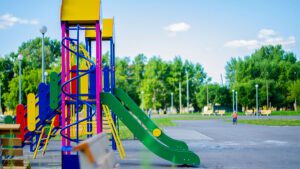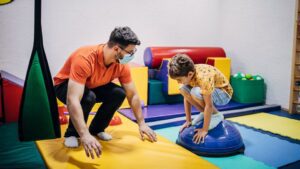Die Bedeutung von integrativen Spielplätzen
Spielplätze sind mehr als nur ein Ort, an dem Kinder Spaß haben können. Sie sind ein wichtiges Umfeld, in dem sich Kinder körperlich, emotional und sozial entwickeln. Vielen Kindern mit Behinderungen entgehen diese wertvollen Möglichkeiten jedoch, weil sie nur begrenzt zugänglich sind. Wir bei SPIKE setzen uns dafür ein, dass Spielplätze barrierefrei gestaltet werden, damit Kinder mit allen Fähigkeiten die Vorteile des Spielens genießen können.
In diesem Artikel wird untersucht, was einen Spielplatz barrierefrei und inklusiv macht, wie diese Merkmale integriert werden können und welche Vorteile die Förderung der Inklusion in Ihrer Gemeinde mit sich bringt.

Was macht einen Spielplatz barrierefrei?
Verständnis der Zugänglichkeitsstandards
Ein barrierefreier Spielplatz gewährleistet, dass Kinder mit unterschiedlichen Fähigkeiten die Geräte nutzen und sich sicher auf dem Platz bewegen können. Laut dem Gesetz für Menschen mit Behinderungen (ADA)müssen alle Spielplätze, die nach dem 15. März 2012 gebaut wurden, bestimmte Richtlinien erfüllen, um als barrierefrei zu gelten.
Zu den wichtigsten Merkmalen der Zugänglichkeit gehören:
- Unbehinderte Routen: Klare, breite Wege, die für Kinder mit Mobilitätshilfen leicht zu begehen sind.
- Umsteigestationen: Bereiche, in denen Kinder in Rollstühlen sicher auf Spielgeräte umsteigen können.
- Zugängliche Wege: Rampen und Wege, die zu den Spielgeräten führen, sorgen für reibungslose Übergänge für alle.
- Sicherheitsbeläge: Materialien, die Stürze abfedern und die ADA-Anforderungen und ASTM 1951-Zertifizierungen für kritische Höhenwerte erfüllen.
Profi-Tipp: Achten Sie bei der Planung eines Spielplatzes darauf, dass die Wege eben sind und dass die wichtigsten Spielgeräte, Toiletten und Parkplätze leicht zu erreichen sind.

Was ist ein inklusiver Spielplatz?
Mehr als Barrierefreiheit
Während Barrierefreiheit es Kindern mit Behinderungen ermöglicht, den Spielplatz zu betreten, schafft ein integrativer Spielplatz eine Umgebung, in der sie gemeinsam mit Gleichaltrigen spielen können. Ein inklusives Design integriert Merkmale, die die soziale Interaktion, die kognitive Entwicklung und die körperliche Aktivität fördern, damit alle Kinder unabhängig von ihren Fähigkeiten die gleichen Erfahrungen machen können.
Zu den wichtigsten Elementen eines integrativen Spielplatzes gehören:
- Sinnliche Spielelemente: Zum Beispiel Musikgeräte oder strukturierte Oberflächen, die Kinder mit sensorischen Verarbeitungsstörungen ansprechen.
- Mehrgenerationen-Design: Räume, in denen Kinder, Betreuer und Familienmitglieder aller Altersgruppen gemeinsam spielen können.
- Stille Räume: Bereiche, in denen sich Kinder mit Autismus-Spektrum-Störungen (ASD) oder Reizüberflutung zurückziehen und neu gruppieren können, ohne sich isoliert zu fühlen.
Profi-Tipp: Ein integrativer Spielplatz fördert das Gefühl der Zugehörigkeit für jedes Kind. Es geht nicht nur darum, die ADA-Richtlinien zu erfüllen, sondern einen Raum zu schaffen, in dem sich jeder willkommen und engagiert fühlt.

Warum sollten Sie Ihren Spielplatz barrierefrei und inklusiv gestalten?
Vorteile von inklusiven und barrierefreien Spielplätzen
Der Bau eines integrativen Spielplatzes ist nicht nur eine gesetzliche Vorschrift, sondern auch eine Investition in das Wohlergehen Ihrer Gemeinde. Die Vorteile sind zahlreich:
- Förderung von Empathie und Akzeptanz: Wenn Kinder mit und ohne Behinderungen zusammen spielen, lernen sie, Unterschiede zu schätzen und entwickeln Empathie, was eine integrative Gesellschaft fördert.
- Förderung der körperlichen und sozialen Entwicklung: Barrierefreie Spielplätze bieten allen Kindern die Möglichkeit, sich körperlich zu betätigen und soziale Kontakte zu knüpfen, wodurch kognitive, emotionale und soziale Fähigkeiten verbessert werden.
- Förderung der Beteiligung der Familie: Ein integrativer Spielplatz sorgt dafür, dass Kinder mit Behinderungen Zeit mit ihren Familien verbringen können, einschließlich der Betreuer mit Mobilitätsproblemen.
- Schaffen Sie ein Gefühl der Gemeinschaft: Ein gut gestalteter, inklusiver Spielplatz bringt die Gemeinschaft zusammen und bietet einen Raum, in dem Kinder und Familien Beziehungen und Erinnerungen aufbauen können.
Profi-Tipp: Indem Sie sich auf Inklusivität konzentrieren, können Sie einen Raum schaffen, der nicht nur die Entwicklung der Kinder fördert, sondern auch den Zusammenhalt der Gemeinschaft stärkt.

Wie man einen Spielplatz barrierefrei und inklusiv gestaltet
Praktische Schritte für die Gestaltung eines barrierefreien Spielplatzes
Um einen barrierefreien und inklusiven Spielplatz zu schaffen, braucht man kein großes Budget. Durch die Umsetzung der folgenden Schritte können Sie Ihren Spielplatz zu einem Ort machen, der alle Kinder willkommen heißt:
- Bewerten Sie Ihren aktuellen Spielplatz: Überprüfen Sie die bestehenden Strukturen und ermitteln Sie die Bereiche, die zugänglich gemacht werden müssen. Stellen Sie sicher, dass die Wege glatt und frei von Hindernissen sind.
- Bewerten Sie die Bedürfnisse Ihrer Gemeinschaft: Informieren Sie sich über die spezifischen Bedürfnisse Ihrer Gemeinde, einschließlich etwaiger sensorischer oder mobiler Anforderungen. Sprechen Sie mit Familien und Experten, um Anregungen zu sammeln.
- Sensorische und interaktive Elemente einbeziehen: Fügen Sie Elemente hinzu, die mehrere Sinne ansprechen, wie z. B. Geräte, die Geräusche erzeugen, taktile Tafeln und Sinneslabyrinthe.
- Rampen und Übergabestationen installieren: Sorgen Sie für sichere und einfach zu benutzende Rampen, Rutschen mit Umsteigestationen und ebenerdige Geräte für einen leichten Zugang.
- Use ADA-Compliant Safety Surfacing: Choose soft, impact-absorbing materials like rubber tiles, engineered wood fiber, or poured-in-place rubber to cushion falls.
Profi-Tipp: Focus on creating a layout that supports social interaction by ensuring there’s enough space for children of all abilities to play together.

Accessible and Inclusive Equipment to Include in Your Playground
To ensure your playground is accessible and inclusive, consider including the following types of equipment:
- Ramps: Ramps enable children using mobility aids to access elevated equipment. Look for ramps with handrails and enough space to accommodate wheelchair users.
- Inclusive Slides: Accessible slides with lower transfer points and enough width for all children to use are essential for fostering inclusion.
- Ground-Level Play Activities: Ground-level activities, such as spinning wheels and sandboxes, allow children to play together, regardless of their ability.
- Sensory Activities: Incorporate musical instruments, textured surfaces, and colorful features to engage children with sensory processing challenges.
- Inclusive Swings: Swings with seats that offer extra support, such as ADA-compliant inclusive swings, allow children of all abilities to experience the thrill of swinging.
Profi-Tipp: Always consult with a playground design professional to ensure your equipment choices align with safety standards and best practices for inclusivity.

Funding Opportunities for Accessible and Inclusive Playgrounds
Creating an accessible and inclusive playground may seem like a big financial undertaking, but there are many resources available to help fund the project. Here are some ways to secure funding:
- Apply for Grants: Organizations like KaBOOM! offer grants for building inclusive playgrounds. Check out our Playground Grant Resource Guide to learn more.
- Host Fundraisers: Organize community fundraisers to raise money for the project. These can also increase community engagement and support.
- Corporate Sponsorships: Reach out to local businesses for sponsorships or partnerships that can provide financial backing.
Profi-Tipp: Engaging the community early on can help spread the word and gather support for your project, both financially and through volunteer efforts.

FAQs About Accessible and Inclusive Playgrounds
What Is the Difference Between Inclusive and Accessible Playgrounds?
Accessible playgrounds meet the minimum requirements of ADA, allowing children with disabilities to access play equipment. Inclusive playgrounds go beyond this, ensuring that children of all abilities can play together and enjoy the same experiences.
How Can Playgrounds Be More Inclusive?
Make your playground more inclusive by adding accessible equipment, ensuring smooth pathways, and incorporating sensory elements for children with different abilities.
Should Playgrounds Be Inclusive for Students of All Abilities?
Yes! Inclusive playgrounds help children learn important social skills like empathy, teamwork, and acceptance, making them more well-rounded and compassionate individuals.
Conclusion: Building an Inclusive Playground for All
Designing an accessible and inclusive playground is one of the most rewarding projects you can undertake. By ensuring that your playground meets the needs of children of all abilities, you’re not just creating a space for play—you’re fostering an environment where every child feels welcome and valued.
At SPIKE Amusement, we provide a wide range of ADA-compliant and inclusive playground equipment designed to meet the needs of all children. Kontaktieren Sie uns heute to start building a playground that everyone can enjoy!




